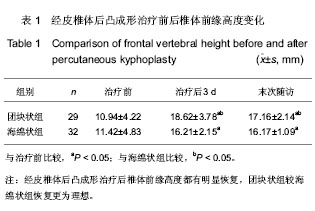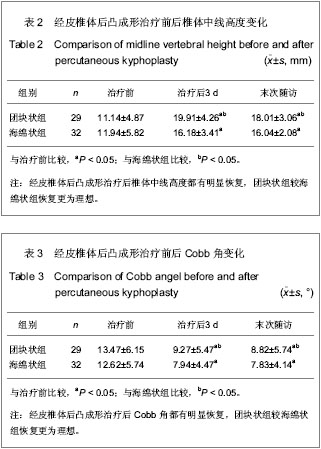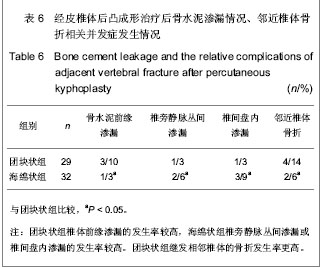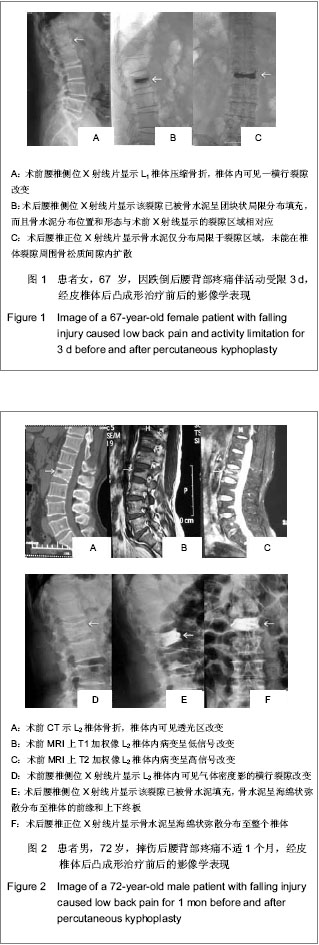| [1] Kim YJ, Lee JW, Kim KJ, et al. Percutaneous vertebroplasty for intravertebral cleft: analysis of therapeutic effects and outcome predictors.Skeletal Radiol. 2010;39(8):757-766.[2] Maldague BE, Noel HM, Malghem JJ.The intravertebral vacuum cleft: a sign of ischemic vertebral collapse. Radiology. 1978;129(1):23-29.[3] Zhang ZD,Zhao HQ,Hao HT. Zhongguo Yixue Yingxiangxue Zazhi. 2009;17 (3):230-232.张子东,赵洪全,郝洪涛.推体缺血性压缩骨折的X线、CT及MRI表现[J].中国医学影像学杂志,2009,17(3):230-232. [4] Wu QX,Ni WF,Chi YL. Jizhu Waike Zazhi. 2012;10(1):56-59.吴爱悯,倪文飞,池永龙. 椎体内裂隙征的形成机理、影像学特征及手术治疗[J].脊柱外科杂志,2012,10(1):56-59.[5] Libicher M, Appelt A, Berger I,et al.The intravertebral vacuum phenomen as specific sign of osteonecrosis in vertebral compression fractures: results from a radiological and histological study.Eur Radiol. 2007;17(9):2248-2252. [6] Maldague BE, Noel HM, Malghem JJ.The intravertebral vacuum cleft: a sign of ischemic vertebral collapse. Radiology. 1978;129(1):23-29.[7] Freedman BA, Heller JG. Kummel disease: a not-so-rare complication of osteoporotic vertebral compression fractures. J Am Board Fam Med. 2009;22(1):75-78.[8] Kaneda K, Asano S, Hashimoto T,et al. The treatment of osteoporotic-posttraumatic vertebral collapse using the Kaneda device and a bioactive ceramic vertebral prosthesis.Spine (Phila Pa 1976). 1992;17(8 Suppl): S295-303.[9] Galibert P, Deramond H, Rosat P, et al. Preliminary note on the treatment of vertebral angioma by percutaneous acrylic vertebroplasty.Neurochirurgie. 1987;33(2):166-168.[10] Jang JS, Kim DY, Lee SH. Efficacy of percutaneous vertebroplasty in the treatment of intravertebral pseudarthrosis associated with noninfected avascular necrosis of the vertebral body. Spine (Phila Pa 1976). 2003; 28(14):1588-1592.[11] Grohs JG, Matzner M, Trieb K,et al.Treatment of intravertebral pseudarthroses by balloon kyphoplasty. J Spinal Disord Tech. 2006;19(8):560-565.[12] Mathis JM. Percutaneous vertebroplasty: complication avoidance and technique optimization. AJNR Am J Neuroradiol. 2003;24(8):1697-1706.[13] Kaneda K, Asano S, Hashimoto T,et al. The treatment of osteoporotic-posttraumatic vertebral collapse using the Kaneda device and a bioactive ceramic vertebral prosthesis.Spine (Phila Pa 1976). 1992 ;17(8 Suppl):S295-303.[14] Krauss M, Hirschfelder H, Tomandl B,et al. Kyphosis reduction and the rate of cement leaks after vertebroplasty of intravertebral clefts. Eur Radiol. 2006;16(5):1015-1021.[15] Baroud G, Vant C, Giannitsios D, et al. Effect of vertebral shell on injection pressure and intravertebral pressure in vertebroplasty.Spine (Phila Pa 1976). 2005;30(1):68-74.[16] Chen LH, Lai PL, Chen WJ.Unipedicle percutaneous vertebroplasty for spinal intraosseous vacuum cleft. Clin Orthop Relat Res. 2005;(435):148-153.[17] Lane JI, Maus TP, Wald JT,et al. Intravertebral clefts opacified during vertebroplasty: pathogenesis, technical implications, and prognostic significance. AJNR Am J Neuroradiol. 2002; 23(10):1642-1646.[18] Jang JS, Kim DY, Lee SH. Efficacy of percutaneous vertebroplasty in the treatment of intravertebral pseudarthrosis associated with noninfected avascular necrosis of the vertebral body.Spine (Phila Pa 1976). 2003;28(14):1588-1592.[19] Trout AT, Kallmes DF, Lane JI,et al. Subsequent vertebral fractures after vertebroplasty: association with intraosseous clefts. AJNR Am J Neuroradiol. 2006;27(7):1586-1591.[20] Wiggins MC, Sehizadeh M, Pilgram TK,et al. Importance of intravertebral fracture clefts in vertebroplasty outcome. AJR Am J Roentgenol. 2007;188(3):634-640.[21] Mousavi P, Roth S, Finkelstein J,et al. Volumetric quantification of cement leakage following percutaneous vertebroplasty in metastatic and osteoporotic vertebrae. J Neurosurg. 2003;99(1 Suppl):56-59. [22] Meng ZB,Li J,Fu K,et al. Shengwu Guke Cailiao yu Linchuang Yanjiu. 2012;9(2):1-4.孟志斌,李俊,付昆,等. PKP 技术治疗骨质疏松性椎体骨折不愈合的临床观察[J].生物骨科材料与临床研究,2012,9(2):1-4.[23] Grohs JG, Matzner M, Trieb K,et al.Treatment of intravertebral pseudarthroses by balloon kyphoplasty. J Spinal Disord Tech. 2006;19(8):560-565.[24] Wiggins MC, Sehizadeh M, Pilgram TK,et al. Importance of intravertebral fracture clefts in vertebroplasty outcome. AJR Am J Roentgenol. 2007;188(3):634-640.[25] Kaufmann TJ, Trout AT, Kallmes DF.The effects of cement volume on clinical outcomes of percutaneous vertebroplasty. AJNR Am J Neuroradiol. 2006;27(9):1933-1937.[26] Liang D,Jiang XB,Yao ZS,et al. Zhongguo Jizhu Jisui Zazhi. 2010;20(3):260-261.粱德,江晓兵,姚珍松,等. 过伸体位下椎体成形术治疗Kümmell病的近期疗效[J].中国脊柱脊髓杂志,2010,20(3): 260-261.[27] Libicher M, Appelt A, Berger I,et al.The intravertebral vacuum phenomen as specific sign of osteonecrosis in vertebral compression fractures: results from a radiological and histological study. Eur Radiol. 2007;17(9):2248-2252.[28] Huang WG,Yi JF,Bai RF,et al. Zhongguo Zuzhi Gongcheng Yanjiu yu Linchuang Kangfu. 2011;15(30):5669-5674.黄卫国,易军飞,白瑞飞,等.椎体成形穿刺注射骨水泥防止灾难性并发症:87例137个椎体资料分析[J].中国组织工程研究与临床康复,2011,15(30):5669-5674.[29] Li DG,Su PJ,Chen GF,et al. Zhongguo Zuzhi Gongcheng Yanjiu. 2012;16(4):713-716.李大刚,苏培基,陈敢峰,等. 椎体成形和椎体后凸成形治疗骨质疏松性椎体压缩骨折的Meta分析[J].中国组织工程研究,2012, 16(4):713-716.[30] Trout AT, Kallmes DF, Lane JI,et al. Subsequent vertebral fractures after vertebroplasty: association with intraosseous clefts. AJNR Am J Neuroradiol. 2006;27(7):1586-1591.[31] Pflugmacher R, Schroeder RJ, Klostermann CK. Incidence of adjacent vertebral fractures in patients treated with balloon kyphoplasty: two years' prospective follow-up. Acta Radiol. 2006;47(8):830-840.[32] Tohmeh AG, Mathis JM, Fenton DC,et al. Biomechanical efficacy of unipedicular versus bipedicular vertebroplasty for the management of osteoporotic compression fractures.Spine (Phila Pa 1976). 1999;24(17):1772-1776.[33] Wang LS,Lv SQ,Tan JW,et al. Zhongguo Weichuang Waike Zazhi. 2011;11(4):338-341.王磊升,吕世桥,谭江威,等. 单侧经皮椎体后凸成形术治疗有“真空裂隙征”的骨质疏松椎体骨折[J].中国微创外科杂志,2011, 11(4):338-341.[34] Liebschner MA, Rosenberg WS, Keaveny TM. Effects of bone cement volume and distribution on vertebral stiffness after vertebroplasty. Spine (Phila Pa 1976). 2001;26(14):1547- 1554. |




